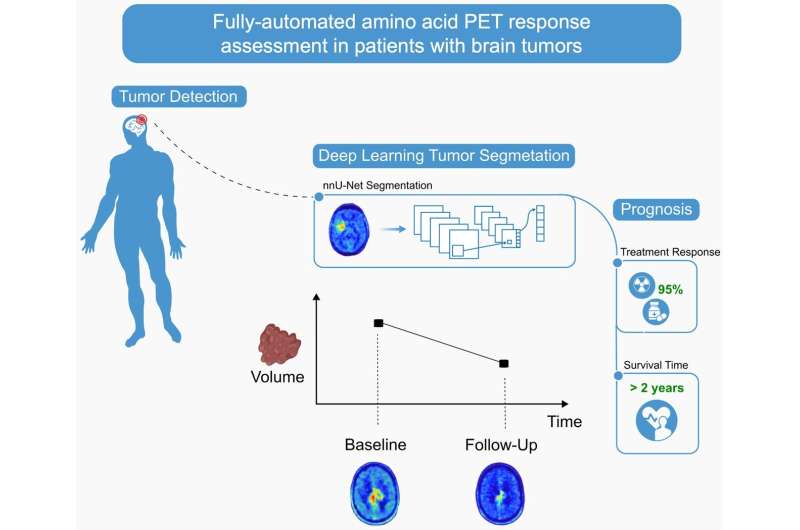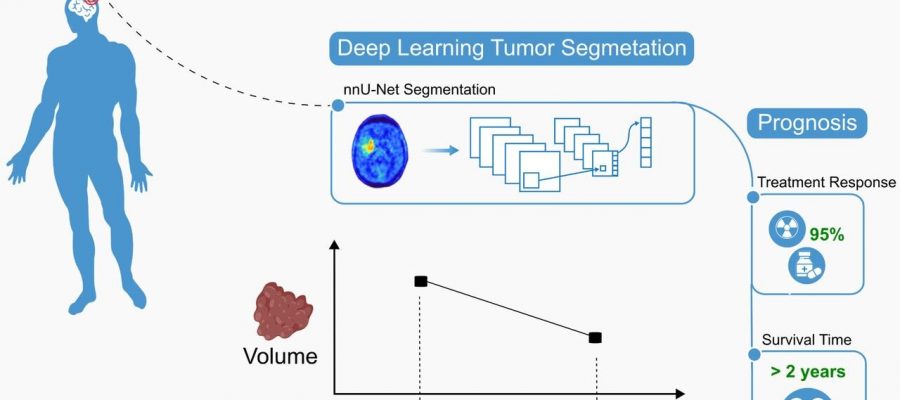
A new artificial intelligence tool provides a fully automated, easy-to-use and objective way to detect and evaluate brain tumors, according to new research published in the October issue of the Journal of Nuclear Medicine. Developed for use with amino acid PET scans, the deep learning–based segmentation algorithm can also assess brain tumor patients’ response to treatment with quality comparable to that of an experienced physician, but in a fraction of the time.
PET has become increasingly important in brain tumor diagnostics, complementing structural MRI. Over the past years, several studies have demonstrated the diagnostic value of the metabolic tumor volume for assessing treatment response in brain tumor patients. However, since measuring changes in the metabolic tumor volume of a brain tumor is time-consuming, it is usually not part of the routine clinical assessment.
“The fact that metabolic tumor volume is not routinely assessed in clinical practice suggests that the time and effort required for volumetric amino acid PET segmentation still exceeds clinical benefit,” said Philipp Lohmann, Ph.D., assistant professor (Habilitation) in Medical Physics, and team leader for Quantitative Image Analysis & AI at the Institute of Neuroscience and Medicine, Research Center in Juelich, Germany.
“In response, our team developed a deep learning-based segmentation algorithm for a robust and fully automated volumetric evaluation of amino acid PET data and evaluated its performance for response assessment in patients with gliomas.”
Researchers retrospectively evaluated 699 18F-FET PET scans (at initial diagnosis or during follow-up) from 555 brain tumor patients. The deep learning-based segmentation algorithm was configured on a training and a test dataset, and changes in metabolic tumor volume were measured. Additionally, the algorithm was applied to data from a recently published 18F-FET PET study on response assessment in glioblastoma patients treated with adjuvant temozolomide chemotherapy. The response assessment from the algorithm was then compared to the assessment of an experienced physician, as reported in the study.
In the test dataset, 92% of lesions with increased uptake and 85% of lesions with isometric or hypometabolic uptake were correctly identified by the algorithm. Change in metabolic tumor volume, as detected by the algorithm, was a significant determinant of disease-free and overall survival, in agreement with the physician’s assessment.
“These findings highlight the value of the deep learning-based segmentation algorithm for improvement and automatization of clinical decision-making based on the volumetric evaluation of amino acid PET,” stated Lohmann. “The segmentation tool developed in our study could be an important platform to further promote amino acid PET and to strengthen its clinical value, which may give brain tumor patients access to important diagnostic information that was previously unavailable or difficult to obtain.”
To facilitate clinical implementation, the segmentation algorithm is freely available and can be executed on a conventional GPU-equipped computer in less than two minutes without preprocessing. “We hope to encourage and support treating physicians in neuro-oncology centers to consider amino acid PET for their patients, even if they have little or no prior experience,” said Lohmann. “Every patient with a brain tumor should have access to amino acid PET.”
More information:
Robin Gutsche et al, Automated Brain Tumor Detection and Segmentation for Treatment Response Assessment Using Amino Acid PET, Journal of Nuclear Medicine (2023). DOI: 10.2967/jnumed.123.265725
Journal information:
Journal of Nuclear Medicine
Source: Read Full Article
